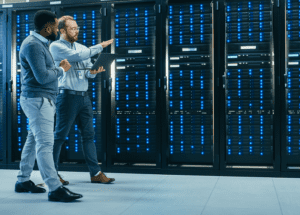We have reached a tipping point in technology, where there are now more connected devices than people in the world. Consequently, we have also reached a tipping point in the data center, where the Internet of Things (IoT) and ensuing demand for connectivity, speed and processing power has pushed the need for these capabilities closer to users — forcing solutions to the “edge.”
At Schneider Electric, we have gotten ahead of these trends by creating a new architecture for the future. Until now, regional data centers have offered a large-scale solution, while local gateways and embedded devices catered to more local increases in demand. The first is slow to build and bring on-line- but powerful, while the second is quick but lacks power and flexibility. In June, we announced our new micro data center solutions bridging the gap as the best of both worlds.
Our solutions were recently highlighted in a report from IDC. The firm stated in the report, “In developing these products, Schneider closely examined the requirements for successful, secure, rapid edge deployments in support of the explosion of edge data.”
Through standardization and factory testing, micro data centers reduce latency, add capacity, enable secure ongoing management and boost reliability — and they can be deployed quickly, almost anywhere. In fact, IDC predicts, “By 2018, cloud, mobile, and IoT services providers will own/operate 30% of IT assets in edge locations and micro data centers.”
Meeting New Business Needs
A micro data center can be defined as: a self-contained, secure computing environment that includes all the storage, processing and networking required to run a customer’s applications.
According to IDC, “Schneider Electric has responded early to customer need for flexibility and security in the manner of implementation of its critical facilities equipment by rolling out the SmartBunker and SmartShelter family of products. Beyond providing the power, cooling, and physical infrastructure, the SmartBunker and SmartShelter micro datacenters (MDCs) incorporate Schneider’s StruxureWare for Data Centers management technology to optimize the use of resources and enable lights-out control over resources. “
With the new demand, there is new pressure on businesses to deliver. IDC calls out enterprise branch offices, and industries like finance, logistics, retail, healthcare and law enforcement, which can particularly benefit from micro data centers. We also see the oil and gas industry and colocation as top opportunities and believe that micro data centers will play an important role in smart cities.
Managing the Future
Overall, the firm predicts: “By 2018, 60% of companies will rely on highly instrumented datacenters that use advanced automation to boost efficiency, as well as tie datacenter and IT spend to business value received. The micro datacenter segment contributes to the growth in these ‘smarter’ data centers with preinstalled sensors and software technology to enable remote visibility and control. Over the next few years, spending on sensors and advanced automation tools will increase, as these are viewed as necessary and enabling technologies, instead of ‘nice to have’ technologies,” according to the report.
In addition to being a part of the smart movement, micro data centers address the future with scale. As more capacity is needed, you can simple add another micro data center.
“IoT workloads and mobile and social technologies are driving the need for edge data resources. A critical tool for managing these resources is the micro datacenter, which facilitates rapid data transmission between companies and their customers with minimal latency,” said Kelly Quinn, research manager, IDC.
We intend to continue to lead in the micro data center space via our solutions and services.



